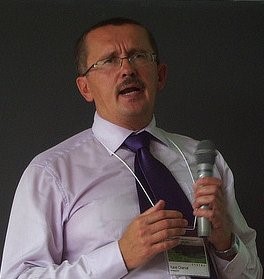Blogpost: PREPSOIL Reforestation Soil Needs Workshop – Žďár nad Zázavou (Czech Republic)

The PREPSOIL workshop on reforestation at Žďár nad Zázavou took place on May 19, 2023 at the Kafíčko” Coffee House.
The workshop was a combination of presentations, interactive engagement using Mentimeter technology, and dialogue with stakeholders. The primary goal of the workshop was to introduce the objectives of the Prepsoil project, as presented by Karel Charvat and Jaroslav Smejkal, and provide an overview of the workshop's content. The workshop included a series of technical presentations, including one with PowerPoint slides explaining the utilization of sensors, conducted by Michal Kepka. The remaining presentations were live demonstrations showcasing various aspects, technologies, and data related to soil management.
One of the presentations featured a composition displaying the types of land cover and their utilization on the agricultural land units (OLU) in Vysocina. This composition included thematic data on land cover classification (Corine) and land utilization classification (HILUCS), derived from the thematic attributes of reference elements. https://www.agrihub.cz/projekty/prepsoil/data-krajinn%C3%A9ho-pokryvu-na-vyso%C4%8Din%C4%9B
Another composition focused on selected agroclimatic growth factors for wheat on agricultural and forest land units in OLU in Vysocina. The thematic data for agroclimatic factors were sourced from the data services available at https://api-agroclimatic.lesprojekt.cz/, while the geometry of land units was obtained from the OLU database. https://www.agrihub.cz/projekty/prepsoil/agroklimatick%C3%A9-faktory-na-vyso%C4%8Din%C4%9B
A third composition presented the individual parameters of BPEJ (Basic Soil Evaluation System) and the score for the point-based evaluation of profitability on agricultural and forest land units in OLU in Vysocina. The thematic data for BPEJ came from the national BPEJ database at and the geometry of land units was derived from the OLU database. https://www.agrihub.cz/projekty/prepsoil/vlastnosti-bpej-vybran%C3%BDch-pozemk%C5%AF-na-vyso%C4%8Din%C4%9B
Next there was a composition focused on assessing the attractiveness of the region in relation to agricultural requirements. The attractiveness was presented in the form of homogeneous clusters of land units with similar attractiveness or as a ranking of land units based on their attractiveness index.https://www.agrihub.cz/projekty/prepsoil/atraktivita-pozemk%C5%AF-na-vyso%C4%8Din%C4%9B/
The last presentation focused on a time series of vegetation indices, specifically the Normalized Difference Vegetation Index (NDVI), masked for forest areas. This time series displayed the development of forest conditions affected by the bark beetle calamity between the years 2017 and 2022. The NDVI is a remote sensing index that provides information about vegetation vigor and health. By analyzing the changes in NDVI over time, it is possible to assess the impact of disturbances, such as the bark beetle calamity, on forest ecosystems. In this presentation, the time series of NDVI for forest areas was visualized, showcasing the progression of forest conditions over the years. The mask applied to the NDVI data ensured that only forested areas were considered, allowing for a focused analysis of the impact of the bark beetle calamity. https://www.agrihub.cz/projekty/prepsoil/v%C3%BDvoj-stavu-les%C5%AF
Throughout the workshop, interactive maps were utilized to showcase different soil-related problems to potential users and stakeholders. These web presentations and interactive maps are accessible at https://www.agrihub.cz/projekty/prepsoil/ .
Overall, the workshop provided an opportunity for knowledge exchange, demonstration of innovative technologies, and engagement with stakeholders. The combination of presentations, interactive elements, and dialogue fostered a collaborative environment to address soil-related challenges in Vysocina and promote sustainable soil management practices. It was also input for following analysis.
